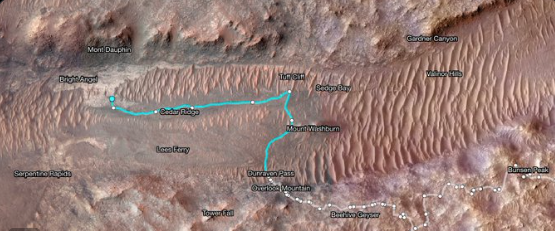Mars will be the object of intense exploration as we begin to enter the age of Elon Musk’s colonization efforts. It’s only a matter of time. In the meantime, for the next few years we still have the rover…
NASA’s Perseverance Mars rover has made a significant discovery in the Neretva Vallis, a location initially considered just a path clear of obstacles. After altering its route to avoid large boulders, the rover reached a new area of interest known as “Bright Angel” on June 9, significantly ahead of schedule. This detour through an ancient river channel not only expedited the rover’s journey but also unveiled unexpected geological features that could offer new insights into Mars’ history.
A route change on my way to Bright Angel has led me through an unexpectedly diverse geological playground, Neretva Vallis! This ancient river channel – which carried most of the water that flowed into Jezero Crater billions of years ago – is filled with intriguing boulders. pic.twitter.com/4faWzFZJpt
— NASA’s Perseverance Mars Rover (@NASAPersevere) June 13, 2024
Currently, in the later stages of its fourth science campaign, Perseverance is focused on exploring the “Margin Unit” near Jezero Crater’s rim. This area is notable for its carbonate and olivine deposits. The Bright Angel site, located at the northern channel wall’s base, features intriguing light-toned rocky outcrops. These outcrops could be either ancient rocks exposed by river erosion or sediments that once filled the channel. The science team is eager to analyze these rocks, hoping they differ from those found in the carbonate-and-olivine-rich Margin Unit, to gather more data about the crater’s geological history.
Navigating the route posed challenges due to increasing boulder sizes, which reduced daily travel distances from over a hundred meters to just tens of meters. The team employed Perseverance’s auto-navigation system, AutoNav, to navigate through rough terrain and around the boulders. However, the abundance of rocks often caused AutoNav to halt the rover’s progress. The successful crossing of a dune field in the river channel eventually opened a direct path to Bright Angel, showcasing the rover’s capability to adapt to Martian terrains.
Superimposed on an image from NASA’s Mars Odyssey orbiter, this map shows Perseverance’s path between Jan. 21 and June 11. White dots indicate where the rover stopped after completing a traverse beside Neretva Vallis river channel. The pale blue line indicates the rover’s route… pic.twitter.com/zdQIUIOA4g
— Black Hole (@konstructivizm) June 14, 2024
Upon reaching the channel floor, Perseverance quickly traveled to its first scientific stop at “Mount Washburn,” where it encountered a hill strewn with unique boulders, marking a significant geological find. Among these, a boulder named “Atoko Point” stood out due to its distinct mineral composition of pyroxene and feldspar and its unique textural properties. This discovery sparked debate among scientists about its origin, whether it was formed from subsurface magma within the crater or transported from beyond Jezero by ancient Martian waters.
Perseverance views “Bright Angel”
The Mars rover was traveling in the channel of an ancient river, Neretva Vallis, when it captured this view of an area of scientific interest nicknamed “Bright Angel” – the light-toned area in the distance at right.https://t.co/7rTwQEw3T6 pic.twitter.com/wSnuK0zo6U
— Daniel Pomarède (@DanielPomarede) June 14, 2024
Perseverance’s journey continued north to “Tuff Cliff” for further geological studies before making a four-sol trip to Bright Angel. The rover is now assessing a rocky outcrop at this location to determine the viability of collecting a core sample. The findings at Bright Angel and the earlier sites could provide critical clues to understanding Mars’ geological processes and history, potentially answering questions about the planet’s past environments and their capability to support life.
Major Points:
- NASA’s Perseverance Mars rover successfully navigated through the Neretva Vallis, reaching the “Bright Angel” area ahead of schedule, thanks to a route change that avoided large boulders.
- The rover is currently exploring the “Margin Unit” near Jezero Crater, focusing on areas rich in carbonate and olivine deposits, aiming to uncover differences in rock formations that could reveal more about the crater’s geological past.
- The journey to Bright Angel was initially slowed by challenging terrain filled with large boulders, but crossing a dune field in the river channel allowed the rover to continue its mission more efficiently.
- At “Mount Washburn,” Perseverance encountered unique geological features, including the distinct boulder “Atoko Point,” which is composed of pyroxene and feldspar, indicating possible origins from subsurface magma or transport by ancient Martian waters.
- The rover’s findings are expected to provide significant insights into Mars’ geological processes, helping scientists understand the planet’s history and its potential to support life.
Conner T – Reprinted with permission of Whatfinger News



